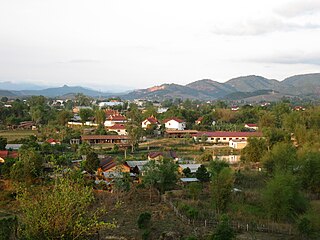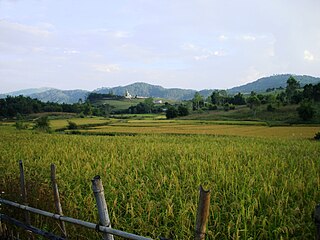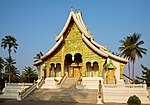
Luang Phabang, or Louangphabang, commonly transliterated into Western languages from the pre-1975 Lao spelling ຫຼວງພຣະບາງ as Luang Prabang, literally meaning "Royal Buddha Image", is a city in north central Laos, consisting of 58 adjacent villages, of which 33 comprise the UNESCO Town of Luang Prabang World Heritage Site. It was listed in 1995 for unique and "remarkably" well preserved architectural, religious and cultural heritage, a blend of the rural and urban developments over several centuries, including the French colonial influences during the 19th and 20th centuries.

Wat Xieng Thong is a Buddhist temple on the northern tip of the peninsula of Luang Phrabang, Laos. Built between 1559 and 1560 by King Setthathirath, Wat Xieng Thong is one of the most important of Lao monasteries and remains a significant monument to the spirit of religion, royalty and traditional art.

Phonsavan, population 37,507, is the capital of Xiangkhouang Province. Phonsavan was built in the late-1970s and replaced the old Xiangkhouang which was destroyed during the Second Indochina War.

Xiangkhouang is a province of Laos on the Xiangkhoang Plateau, in the nation's northeast. The province has the distinction of being the most heavily bombed place on Earth.

Luang Prabang is a province in northern Laos. Its capital of the same name, Luang Prabang, was the capital of the Lan Xang Kingdom during the 13th to 16th centuries. It is listed since 1995 by UNESCO as a World Heritage Site for unique architectural, religious and cultural heritage, a blend of the rural and urban developments over several centuries, including the French colonial influences during the 19th and 20th centuries. The province has 12 districts. The Royal Palace, the national museum in the capital city, and the Phou Loei Protected Reserve are important sites. Notable temples in the province are the Wat Xieng Thong, Wat Wisunarat, Wat Sen, Wat Xieng Muan, and Wat Manorom. The Lao New Year is celebrated in April as The Bun Pi Mai.
Belmond La Résidence Phou Vao is resort on a hilltop on the edge of the UNESCO World Heritage Site of Luang Prabang in Laos. Luang Prabang sits at the junction of the Mekong and Nam Khan rivers. The resort has large gardens with a spa and swimming pool which directly faces Phou si hill. It was acquired by Orient-Express Hotels in 2006. In 2014, the company changed its name to Belmond Ltd. and the hotel was renamed Belmond La Résidence Phou Vao.












